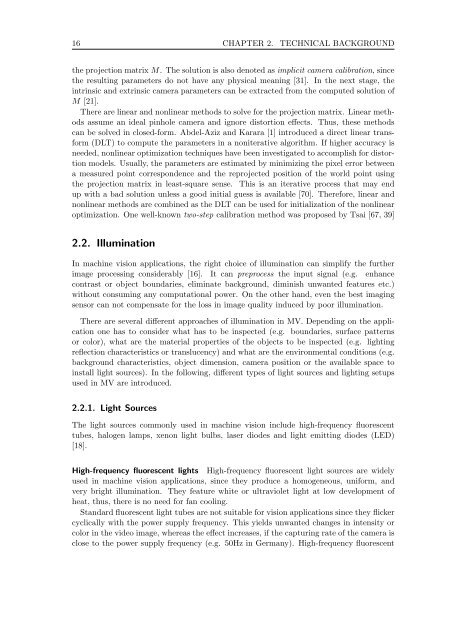Master Thesis - Fachbereich Informatik
Master Thesis - Fachbereich Informatik
Master Thesis - Fachbereich Informatik
You also want an ePaper? Increase the reach of your titles
YUMPU automatically turns print PDFs into web optimized ePapers that Google loves.
16 CHAPTER 2. TECHNICAL BACKGROUND<br />
the projection matrix M. The solution is also denoted as implicit camera calibration, since<br />
the resulting parameters do not have any physical meaning [31]. In the next stage, the<br />
intrinsic and extrinsic camera parameters can be extracted from the computed solution of<br />
M [21].<br />
There are linear and nonlinear methods to solve for the projection matrix. Linear methods<br />
assume an ideal pinhole camera and ignore distortion effects. Thus, these methods<br />
can be solved in closed-form. Abdel-Aziz and Karara [1] introduced a direct linear transform<br />
(DLT) to compute the parameters in a noniterative algorithm. If higher accuracy is<br />
needed, nonlinear optimization techniques have been investigated to accomplish for distortion<br />
models. Usually, the parameters are estimated by minimizing the pixel error between<br />
a measured point correspondence and the reprojected position of the world point using<br />
the projection matrix in least-square sense. This is an iterative process that may end<br />
up with a bad solution unless a good initial guess is available [70]. Therefore, linear and<br />
nonlinear methods are combined as the DLT can be used for initialization of the nonlinear<br />
optimization. One well-known two-step calibration method was proposed by Tsai [67, 39]<br />
2.2. Illumination<br />
In machine vision applications, the right choice of illumination can simplify the further<br />
image processing considerably [16]. It can preprocess the input signal (e.g. enhance<br />
contrast or object boundaries, eliminate background, diminish unwanted features etc.)<br />
without consuming any computational power. On the other hand, even the best imaging<br />
sensor can not compensate for the loss in image quality induced by poor illumination.<br />
There are several different approaches of illumination in MV. Depending on the application<br />
one has to consider what has to be inspected (e.g. boundaries, surface patterns<br />
or color), what are the material properties of the objects to be inspected (e.g. lighting<br />
reflection characteristics or translucency) and what are the environmental conditions (e.g.<br />
background characteristics, object dimension, camera position or the available space to<br />
install light sources). In the following, different types of light sources and lighting setups<br />
used in MV are introduced.<br />
2.2.1. Light Sources<br />
The light sources commonly used in machine vision include high-frequency fluorescent<br />
tubes, halogen lamps, xenon light bulbs, laser diodes and light emitting diodes (LED)<br />
[18].<br />
High-frequency fluorescent lights High-frequency fluorescent light sources are widely<br />
used in machine vision applications, since they produce a homogeneous, uniform, and<br />
very bright illumination. They feature white or ultraviolet light at low development of<br />
heat, thus, there is no need for fan cooling.<br />
Standard fluorescent light tubes are not suitable for vision applications since they flicker<br />
cyclically with the power supply frequency. This yields unwanted changes in intensity or<br />
color in the video image, whereas the effect increases, if the capturing rate of the camera is<br />
close to the power supply frequency (e.g. 50Hz in Germany). High-frequency fluorescent














